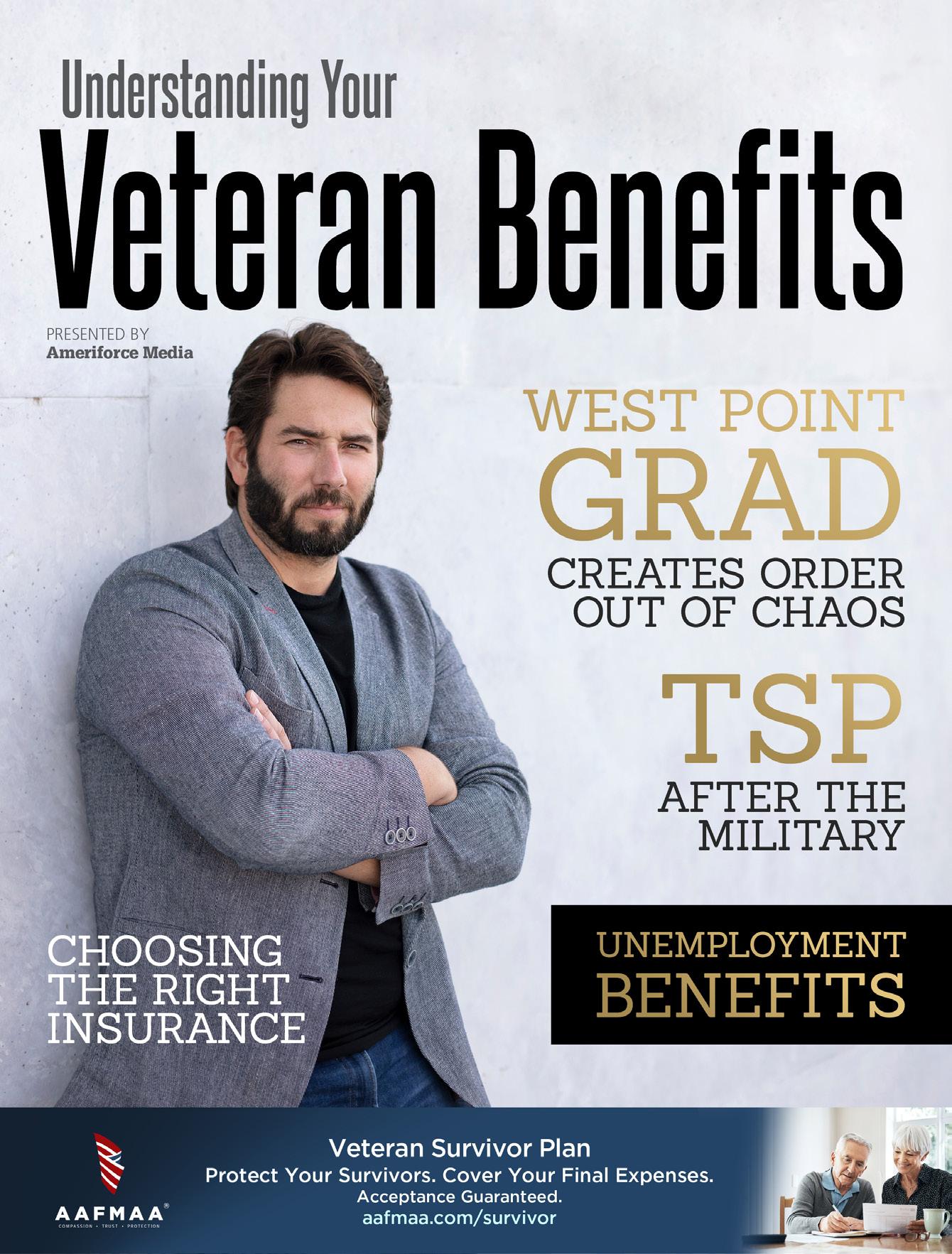






When we were building this issue, our team raced to pull the pieces together because one half of our cover feature, Mike Gomolka — co-founder of Project 33 Memorial Foundation — was due to deploy overseas. In fact, we are very accustomed to adapting plans because timelines change according to mission requirements. Little did we know an even greater disruption to life as we knew it was brewing; a threat so grave that it would trump military orders, drill weekends, PCS moves and the health of Mike’s wife Samantha, a physician assistant. She was diagnosed with COVID-19 as we were working on her feature story.
We are happy to report the Gomolka family is on the mend, and the couple can focus its attention on where it typically lies every year at this time: honoring Special Forces soldiers killed since


September 11th. As with so many parts of our normal routines, this year’s Memorial Day ceremonies may look a little different because of pandemic restrictions, but we owe it to our Gold Star families to find some creative way to pause, reflect and speak the names of their loves ones who gave so much.
This year Project 33 honors Master Sgt. Nicholas Sheperty who served with the West Virginia Army National Guard. He enlisted in 2002, serving tours in Iraq and Afghanistan. Sheperty was a member of the elite Green Berets, according to a press release, and joined West Virginia Army National Guard in 2010. He was 36 years old at the time of his death.
We join the nation in honoring the service of all of our fallen, this Memorial Day and every day that we remain free because of their sacrifice.
The Reserve & National Guard is published six times a year for reservists and members of the National Guard. Copies are available through participating Reserve and National Guard training centers at no cost.
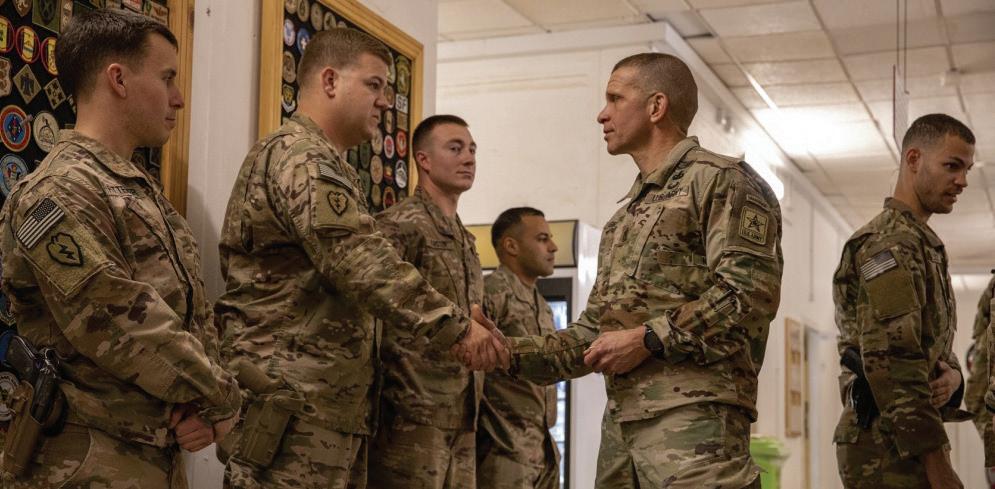

Unit distribution requests can be made online at:
AmeriForceMedia.com/rng/print-magazines/ Individuals can order a free digital edition of this guide at: AmeriForceMedia.com/rng/subscribe-free/ Editorial comments can be emailed to: managing.editor@ameriforcemedia.com
The Reserve & National Guard by AmeriForce Media is published by AmeriForce Media, LLC, Bloomington, Ind., a private company. Information and advertisements in this publication do not constitute endorsement by any branch of the military or the Department of Defense. No part of this publication may be copied without the express written permission of the publisher. AmeriForce Media, LLC, the publisher, and publisher’s agents make no endorsement of any advertised services or products and none should be inferred.
President and Publisher Todd Taranto
Managing Editor Bianca M. Strzalkowski
Design Open-Look Business Solutions
ADVERTISING
PLEASE CALL 703-337-8100
Todd Taranto Publisher
Todd.Taranto@AmeriForceMedia.com
Julie Miller
Vice President, Sales

Julie.Miller@AmeriForceMedia.com
Brian Dunbar
Director of Business Development
Brian.Dunbar@AmeriForceMedia.com
Ursula Hirschhaeuser
Germany Sales +49 (0) 69-15053980
Ursula-Hirschhaeuser@t-online.de




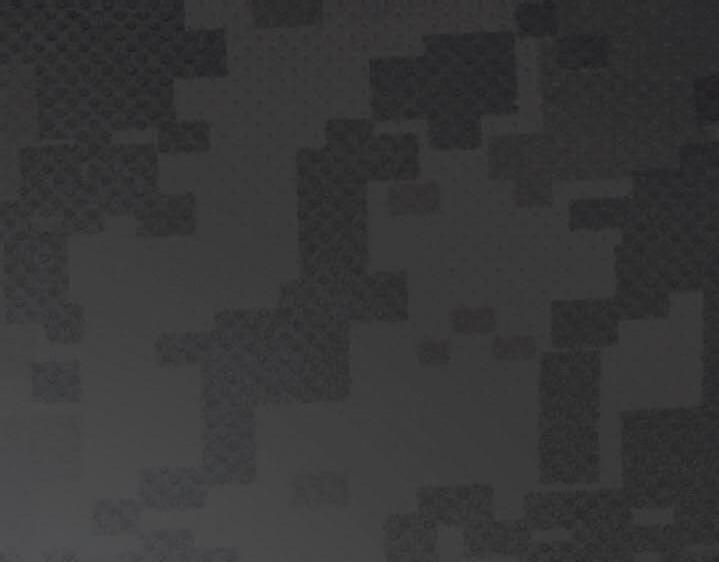








































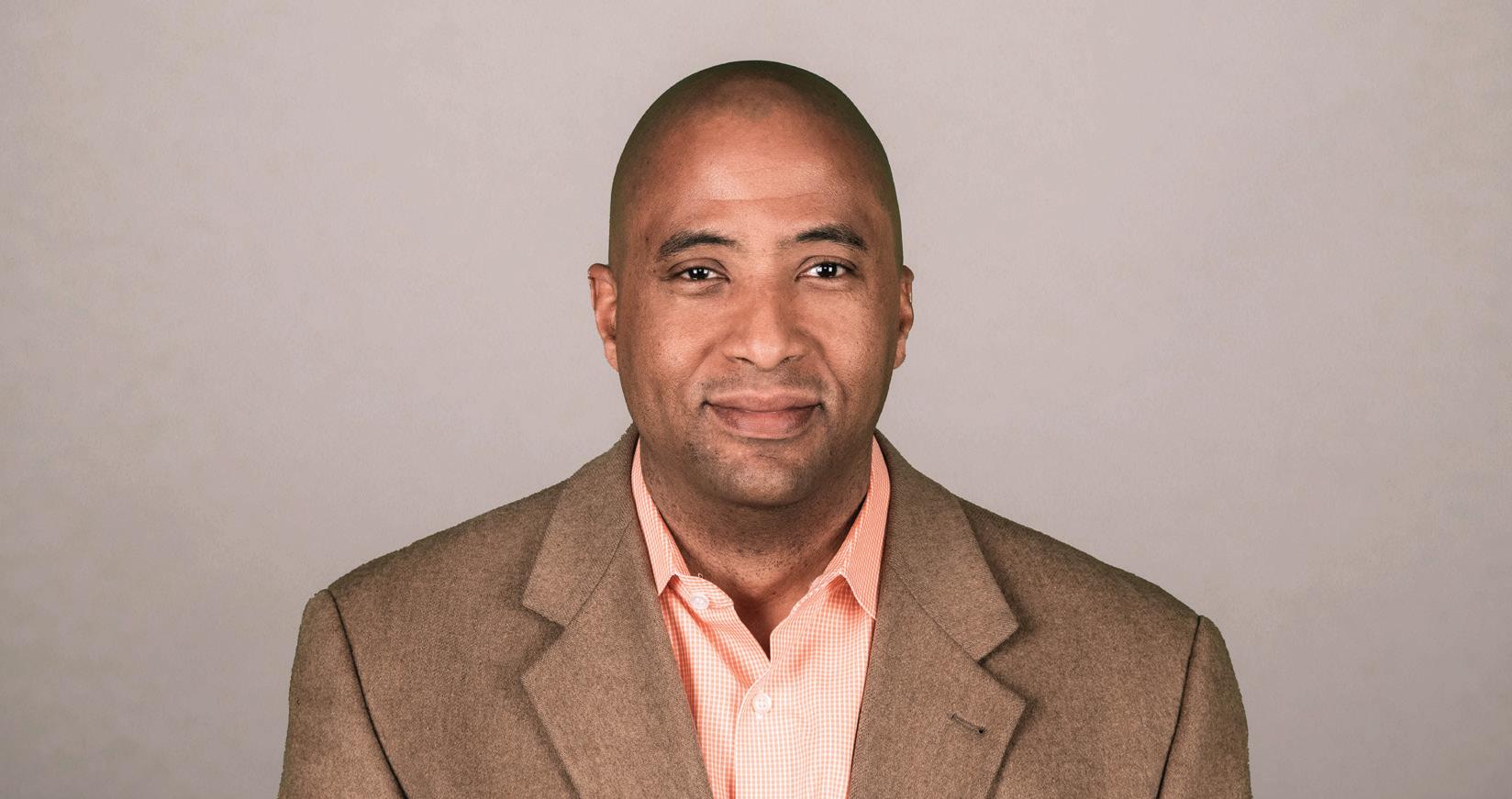
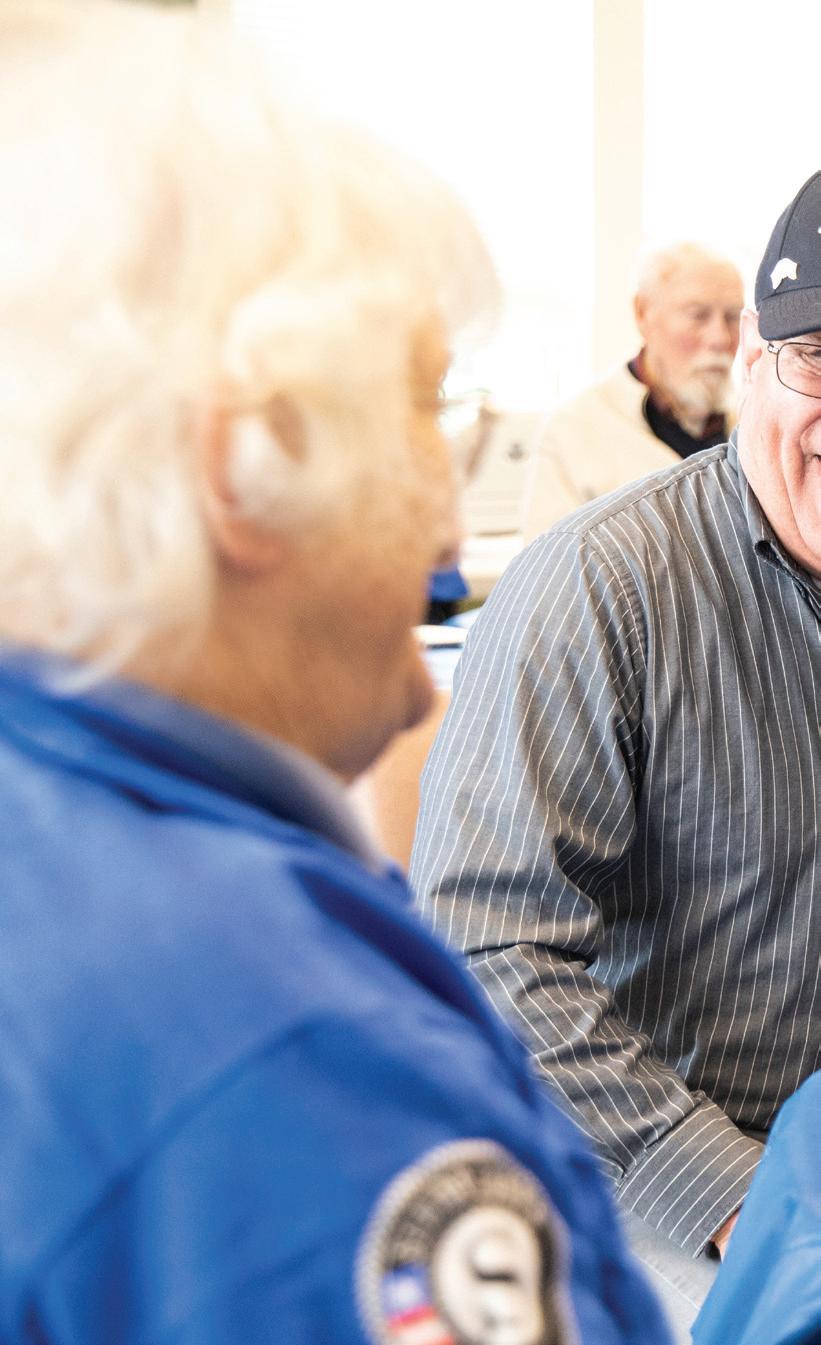
 By Dr. Joseph J. Heck
By Dr. Joseph J. Heck
An ethos of service comes naturally to those in the military — a desire to serve the country is why many join in the first place. In March, the National Commission on Military, National, and Public Service, of which I am honored to serve as Chairman, released its final report, Inspired to Serve. The report, issued to Congress, the President, and the American public, includes more than 160 recommendations to strengthen national mobilization, enhance participation in military, national, and public service, and build on America’s culture of service.

The Commission’s research confirmed what I have witnessed countless times: service remains a bedrock of veterans’ lives, even after they transition from the military. In 2017, nearly 40% of new, full-time federal hires were veterans, and more than 20,000 veterans continue their service in AmeriCorps and Senior Corps every year. The Commission’s recommendations aim to improve pathways for veterans who wish to continue serving their country … Heroes in search of their next mission .
For many who aspire to public service — veterans and nonveterans alike — USAJOBS represents a source of frustration, where individuals submit applications without ever hearing anything in return. Many who apply are also unaware that the federal government has over a hundred different hiring authorities specifying who is eligible to apply and be hired for certain jobs. For instance, some veterans receive a hiring preference within the government’s most widely used hiring process, competitive examining, and qualify for several other special noncompetitive authorities . Yet, too often, veterans
are unaware that they are eligible for these preferences and authorities or how to effectively use them. The Commission’s report includes recommendations to fix basic hiring processes and enhance pathways to federal employment for transitioning veterans.
The Commission heard significant feedback from veterans, agency
chief human capital officers, and subject matter experts that veterans’ preference, as it is currently applied, does not work well, particularly for young veterans. It also prevents agencies from accessing the talent they need to fulfill their critical missions. The Commission’s proposals would enhance and modernize the veterans’ preference process to help agencies meet their workforce needs while improving its utility for transitioning veterans of the wars in Iraq and Afghanistan.
At the same time, the Commission recommends greatly expanding Veterans’ Recruitment Appointment (VRA), a hiring authority that allows all recently-discharged veterans to be hired without competing against other candidates. Currently, eligibility for the authority is capped at three years after discharge — a time when many young veterans are using their GI-Bill benefits to attend school. The Commission proposes extending this eligibility to 10 years after discharge and recommends including training on this and other federal
hiring mechanisms for veterans in the military’s Transition Assistance Program (TAP). The Commission would also make it easier for agencies to hire veterans through the creation of noncompetitive hiring rosters and instant notification to hiring managers when someone who is VRA-eligible applies for a job. Taken together, these changes will allow veterans to more easily apply the formidable skills they developed in the military towards a new mission in public service.
For veterans uninterested in public service, national service might be the answer. Each year, hundreds of thousands of Americans participate in national service, helping tackle unmet needs of the nation. National service programs, such as those offered by the Corporation for National and Community Service, address unique local challenges across the country, including education, economic opportunity, health, environmental conservation, as well as disaster preparedness and recovery.
Veterans are well-suited to national service, which offers an opportunity to make an impact by applying their leadership and specialized skills while also providing a continued sense of mission. Several veteran-centric groups, such as Team Rubicon , The Mission Continues , and Veterans Fire Corps , already operate in this space. The Commission recommends including materials on different national service opportunities in TAP and encourages the development of incentives for prior service members, in recognition of the value brought by those who choose to continue to serve. It also recommends new joint recruiting initiatives that would help Americans ineligible for military or national service learn about opportunities to serve their country in other ways.

The Commission represents the first holistic examination of service to the nation, in all forms. It put forth a bold vision, ‘every American, inspired and eager to serve.’ As uniformed members of the armed forces, your dedication to the ideal of service has already inspired many. How will you serve next?
Dr. Joseph J. Heck chairs the National Commission on Military, National, and Public Service. He is a Brigadier General in the Army Reserve, a physician, and a former Member of Congress from Nevada. For more information on the Commission’s vision and recommendations, please visit https:// inspire2serve.gov/reports

Being nominated to be the 2019 Iowa Air National Guard Airman of the Year came as a surprise to Airman 1st Class Hannah Christensen. She said even her supervisors don’t know who nominated her.

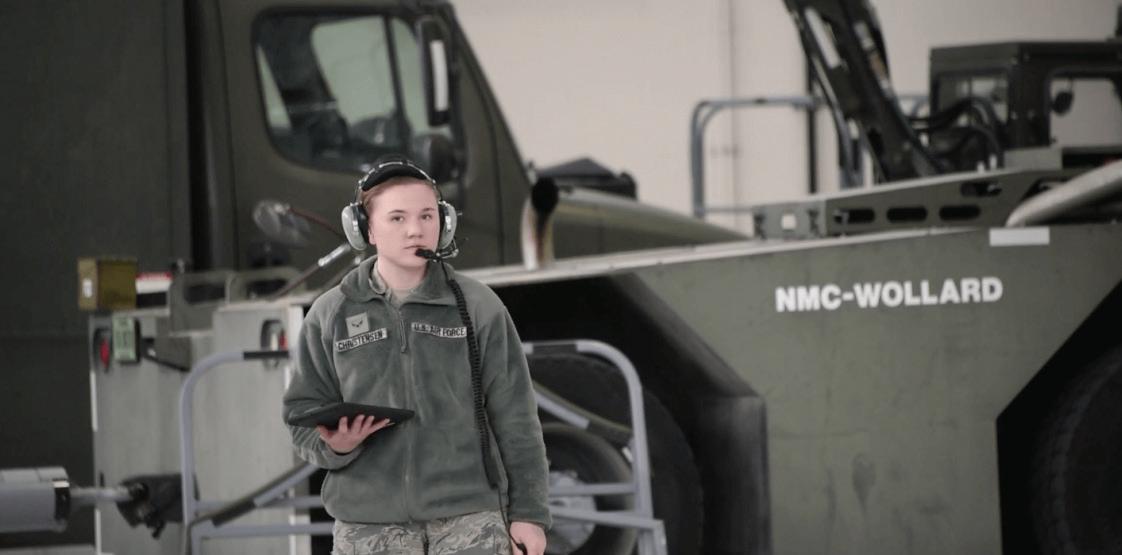
“This whole thing kind of happened without me knowing,” Christensen said. “All of the sudden my supervisor was like, ‘hey, just letting you know you have to go and get your picture taken.”
Though she doesn’t know how she was nominated, Christensen seems pretty sure she knows why she won. She credits the combination of her performance at work and training, but also community service activities.
“It’s a mixture of doing your job and being outstanding at it, as well as helping the people around you, working hard and doing things in your community also,” Christensen said. “There’s a lot of different components to it.”
Christensen is a KC-135 crew chief assigned to the 185th Air Refueling Wing in Sioux City, Iowa. Despite having served only around two years, she’s checked a lot of boxes. She started by taking a year off from Iowa State University where she studies industrial engineering to attend basic training, then technical school at Shepherd Air Force Base, Texas. While in tech school she served as an Airman Leader, helping
military training leaders ensure a good work environment for her fellow airmen.
“When I got back, I went straight into working for the Air Mobility Command Tanker Airlift Control Center,” she said. “I kind of just dove right in to doing whatever I could and volunteering where I could”.
She has also worked on “volunteer deployments” to England and Spain.
When she’s not performing her National Guard duties or attending classes, Christensen spends considerable time on community service.
She’s volunteered with the Society of Women Engineers at elementary schools where she helped children build catapults form popsicle sticks. She works with her local 4-H Club to help young people learn how to show projects at fairs. She’s also helped decorate cookies at nursing homes.
Christensen said her interest in community service was instilled in her by her family, who also have been at least part of what inspired her to join the Air National Guard. She is one of five siblings. All have served in the Iowa Air National Guard.

“It’s been a really great experience because it’s something we can all relate to,” Christensen said. “It was also a great stress reliever for our parents because they didn’t have to pay for college for five kids.”
Christensen grew up on a farm five miles outside the town of Sergeant Bluff, Iowa. It was there, she says, that her upbringing taught her work ethic and a community serviceoriented attitude.
She spent eight years in her local 4-H Club, where she raised rabbits for six years and showed goats and dogs for two years. Her family also hosts visitors to their farm, showing them animals and demonstrating chores.
As busy as she stays, Christensen said people don’t need to match her energy levels to match her accomplishments. They just need to put in the work.
“I would say you need the drive to learn your job as well as you can, as well as being there to support the people around you,” Christensen said. “And just working really hard was a big thing for me. In my shop
you have to put in the work to learn your job and seek mentorship from the people around you.”
Part of being named airman of the year includes a parking space and a certificate. She would also have received recognition at a statewide National Guard conference, but the event was canceled due to the ongoing coronavirus pandemic.
Despite not being able to attend the event, she said she is honored to be airman of the year.
“It’s an amazing opportunity to represent my fellow airmen in Iowa,” she said. “I’m not only representing myself, I’m representing the other airmen who are just like me all across the state.”
A National Guard couple is shining a light this Memorial Day on fallen Army Special Operations soldiers to ensure those who paid the ultimate price are not forgotten.
Army Chief Warrant Officer 2 Michael Gomolka and his wife, Samantha, are co-founders of the Project 33 Memorial Foundation. They formed the nonprofit in 2018 to honor Special Operations soldiers who have died in action since Sept. 11, 2001.

Gomolka served as an Army Ranger from 2000 to 2004 before transitioning to the National Guard, where he has remained on fulltime duty as a Special Operations soldier. He currently is assigned to the 2nd Battalion, 19th Special Forces Group (Airborne) of the West Virginia National Guard, but lives in Hamburg, New York.
As his list of friends killed in the line of duty grew, Gomolka decided to honor their memory on Memorial Day 2017.
He told Samantha he was going to run in body armor carrying a flag through their hometown and finish at the local brewery, where he would hoist a beer in his Ranger buddies’ honor.
Samantha told Michael to think bigger.
“She was the one that said people are going to want to do this with you,” Michael said. “This is going to be big. You should open this up to everybody.”
Project 33’s 6.8-mile Memorial Day Run rapidly has grown beyond the 40 people who joined Michael on his inaugural run. Virtual runs now take place on Memorial Day in several states, raising money for the Project 33 Memorial Foundation and honoring that year’s soldier.
“People showing up by word of social media and bringing their lawn chairs on the side of the road and having people cheer is amazing,” Samantha said. “You say it’s not possible to run seven miles with goosebumps and tears in your eyes and I assure the naysayers it absolutely is. It is such an emotional experience.”
This year’s Memorial Day run will honor Master Sgt. Nicholas Sheperty, 36, a 2/19 SFG soldier and Virginia native who died last April in a military freefall operation. Previous honorees were Army Ranger Spc. Jonn J. Edmunds and Spc. Kristofer T. Stoneisfer of the 34th Battalion, 75th Ranger Regiment. Both men were killed in action on Oct. 19, 2001, when their helicopter crashed in Pakistan.

Both Michael and Samantha serve on the Project 33 board, with Michael as president and Samantha as secretary. Michael credits Project 33’s board members with being the organization’s problem-solving “backbone” and the embodiment of its core values: Represent the fallen with dignity and never bring discredit to the families of those they honor. Maintain financial transparency.
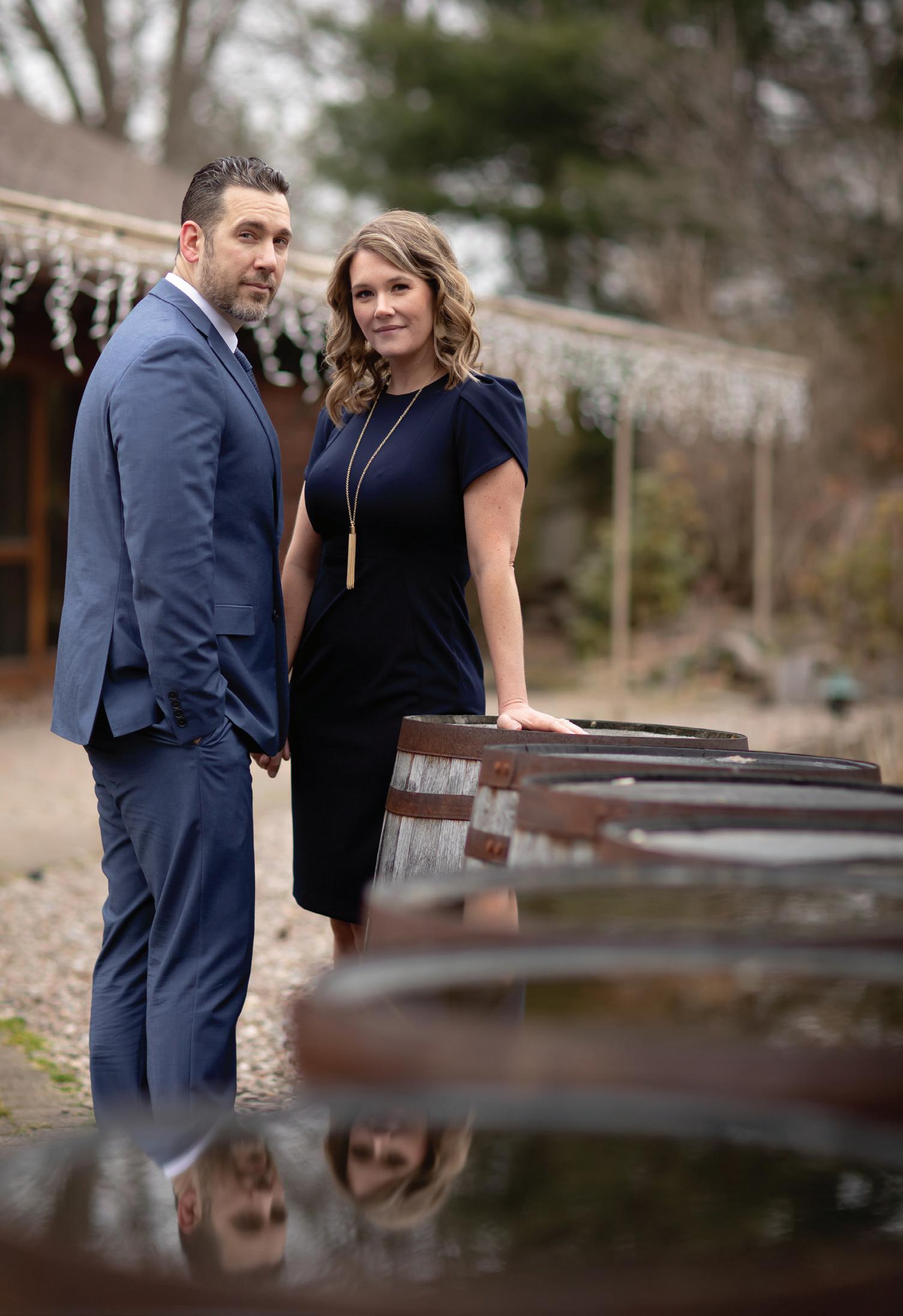
“If you don’t let people know where the money is going and show proof of that, especially in the Special Operations community, they will not support you. You have one chance to get it right,” Michael said of the financial side of running a military nonprofit.
Michael said he anticipates hanging up his uniform for the last time in the next two to three years. Until he transitions to civilian life on 17-acres that will become “Old Man Gomolka’s Christmas Tree Farm,” the couple’s ambitions for Project 33 will remain squarely focused on
each year’s honoree.
“When we fundraise for the Soldier of the Year, the family’s appreciative of the money,” Samantha said. “But the comments always go back to ‘Thank you for saying his name. Thank you for letting others know.’”
Every service member is trained to lead. This is true whether they are active component, reserve or National Guard. Just as the military leverages best practices used by industries, civilian companies can leverage the tools, traits and values that have molded veterans into leaders.
Military reservists and National Guardsmen have adopted military traits, were trained on military tools and methods and have internalized military values. These traits, tools, methods and values are valuable to anyone who wants to grow a civilian company into a profitable enterprise. Civilian
organizations can leverage these military attributes to engage employees, customers and vendors. This promotes a healthier business environment and enables efficiency, effectiveness and profitability.
Military reservists and National Guardsmen are in a unique position. About 15% of reservists or guardsmen serve fulltime in the military, meaning 85% maintain fulltime careers in the civilian workforce. These service members continue to assimilate military traits, tools and values regularly at periodic training events, which is a bonus for employers. Leadership training — and training in other intangibles
such as resiliency and core values — comes with a high price tag in the civilian sector. The civilian employer reaps significant benefits from leadership training, not to mention the operational leadership experience reservists receive.
The military develops leaders. Leadership is inherent in any position a service member assumes. Military personnel, regardless of rank, often find themselves leading other people. Leadership training in the military is not only academic or theoretical but it is also practical and operational. In the military, one not only learns leadership, but everyone will experience the opportunity to lead others.
 Gronski, then-deputy commanding general for the Army National Guard and acting deputy commanding general for the United States Army Europe talks to 2d Cavalry Regiment at the opening ceremony of Noble Partner 2018 at Vaziani Air Field, Georgia. Photo by Sgt. 1st Class Robert Jordan.
Gronski, then-deputy commanding general for the Army National Guard and acting deputy commanding general for the United States Army Europe talks to 2d Cavalry Regiment at the opening ceremony of Noble Partner 2018 at Vaziani Air Field, Georgia. Photo by Sgt. 1st Class Robert Jordan.
Three traits military personnel adopt are self-discipline, respect and resilience. All three are key in the makeup of any service member. Military personnel are exposed to these traits at entry-level training and throughout military service. These traits are important to any business or organization. The difference is that in the military, these traits are foundational and good service members adopt these traits because they are core to military service. One must exhibit the traits to lead effectively.
Respect for others is an important trait veterans adopt. It is impossible to be a toxic leader if you treat subordinates with dignity and respect. This does not mean you cannot hold people to the prescribed standard and counsel them. However, there is a dignified and respectful way to do that. When we talk about being respectful to someone, it not only applies on an emotional level by the words we say or the tone of voice we use.
It is also about being respectful of a person’s time. We must strive to be on time for meetings we call. A leader should also show respect for other’s opinions. A good practice is for a leader to ask followers what they think and how they believe an issue should be handled. Gen. Patton once said a leader should tell followers what to do and why they need to do it, then let the followers figure out how to get it done. He went on to say followers will surprise you by their initiative and creativity.
Resilience is another trait veterans adopt. Leaders must demonstrate courage and optimism in challenging times. Although overcoming adversity is an essential element of resiliency, there are
other components. A leader must have positive energy. A good leader should brighten up a room by entering it, not by leaving it. One of the worst things an organization could endure is an energy sponge who saps the energy from everyone around them because of a negative attitude. Fitness is also a key element of resiliency. This is not only about physical fitness but striving to have balance in all the components of fitness to include physical, spiritual, emotional, social and family fitness. Good leaders strengthen all elements of fitness now, so when a challenge comes their way, they will have the fortitude to stand up to it.
Three tools and methods service members learn are the decisionmaking process, communication and how to gain lessons from a training event or real-world operation.
Leaders must be comfortable making decisions with less than perfect information. The late Jack Welch, former CEO of General Electric, said the primary failure he observed in mid-level managers at GE was they did not have the courage to make decisions. By following the steps in the decision-making process, senior leaders gain an understanding of an issue or problem, visualize success, describe the path to success and provide direction to the team at critical points. Leaders guide teams through the decisionmaking process of conducting an analysis of the problem at hand, factoring in the organizational values then developing, analyzing and comparing options. When these steps are complete, the leader can make a decision based on team recommendations. While many who
never served in the military may have been exposed to this process in business school, veterans have been trained on the decision-making process through the course of their military experience and they have used it regularly.
Leaders spend about 90% of their time communicating. The military trains service members to communicate clearly and concisely. Military personnel are trained to provide teammates a task, a condition to perform the task within and the standard to measure success. Next, they receive a back brief to mitigate the risk of misunderstanding. Senior military leaders learn to deliver “intent” prior to a project or operations that clearly explains why the initiative is being carried out. This includes the purpose, the key tasks that are essential in order to achieve success and what success looks like. Providing purpose, key tasks and the end state is a proven method to ensure the team understands expectations.
Another method military personnel are trained on is conducting a lesson learned session, known in militaryspeak as an after-action review. Once a training event or operation is completed, leaders gather the team together to identify what actions the team should sustain and what needs improvement.
The military places great emphasis on values.The military develops leaders who add a great deal to civilian organizations they eventually transition to. The traits our veterans adopt, the methods they are trained on and the values they internalize are a true value add to any civilian business or organization.
Maj. Jean Marie Kratzer was the only member of the National Guard awarded the Army’s Joint Women’s Leadership in Excellence Meritorious Service Award last summer at the Joint Women’s Leadership Symposium, an annual gathering of military women from all branches of service in Washington, D.C.
“I am beyond grateful for the recognition,” Kratzer said. “It has been a busy decade for me. I’ve been away more than I’ve been home, but I have greatly enjoyed every stressful moment of it. The soldiers in the New York National Guard I have met and worked with have made it worth it.”
Nominated by both one- and twostar generals for the award, Kratzer ranks receiving the honor from the Department of the Army as one of her proudest career achievements so far. She also cites working with a group of soldiers establishing the first mailroom in Syria for a U.S. military base and being a positive influence in the lives of her fellow soldiers.
“As a woman soldier and an officer, a message I would share to other women wanting to join the Guard is: Every day you should feel empowered for the strong career choice you made,” she said. “In no way should it diminish our femininity, or our career choices, but remember
to always be a little louder when you speak. It always catches the predominantly male audience in the room off guard.”
Kratzer, a civilian employee of the Army National Guard, serves as the command information officer for the New York National Guard’s Public Affairs Office in Latham, New York. She is also the public affairs officer for the 42nd Infantry Division’s Headquarters and Support Company in Troy, New York. She has volunteered for her last two out of three deployments because she simply loves serving. In fact, she recently deployed to Kuwait, where she and her team are overseeing all of the public affairs work for more than 10,000 soldiers in several different locations throughout the Middle East.
“Our goal is to project a professional image of soldiers overseas, but also to instill trust, faith and confidence to our leadership and our families back at home,” she said.
Back home for Kratzer is Upstate New York, where she grew up interested in the military. In addition to an aunt who served in the early 2000s, one of Kratzer’s biggest inspirations was her grandfather, who served more than 40 years in the Air Force before retiring as a senior master sergeant. His service spanned World War II, Korea and Vietnam.
“Ever since I was a little kid I would see a military commercial and get chills,” she said.
Before Kratzer’s father passed away when she was 7, he told her that God put her on Earth to help people. Keeping his message close to her heart, in 2007 Kratzer followed in the footsteps of her grandfather and aunt and enlisted in the Army Reserve as a chaplain’s assistant. She became an officer in 2010 after earning a commission through the Reserve Officers Training Corps.
Kratzer has served as a platoon leader, public affairs officer, personnel officer, company commander, sexual assault response coordinator, equal opportunity officer and human resource operations branch chief. She conducts victim’s advocacy and counseling classes and equal opportunity training for New York Army National Guard units across the state.

“I believe the Army has always been the perfect career path for me,” Kratzer said. “I have been able to lead and work with soldiers as a company commander, but nothing gives me more self-fulfillment than being there to support, help, and mentor young soldiers in the Guard.”
When Kratzer enlisted she promised her mother she would earn a college
degree. She graduated from St. John’s University with a degree in sociology with a minor in theology and Christian marriage counseling. She then earned her graduate degree from St. John’s University in criminology and criminal justice with a concentration in international social work and social development.
“The Guard has shaped me to appreciate life — from showering with shower shoes to having the opportunity to see my family on a regular basis. This is my third deployment to the Middle East, but it has also showed me independence, discipline, love of country, lifetime friendships, and the opportunity to travel,” she said.

Through the Guard, Kratzer discovered one of her greatest loves: running. An accomplished and dedicated long-distance runner for nearly a decade, Kratzer is a member of the National Guard Marathon team, which boasts the top ranked 15 women soldiers in the entire country. A self-proclaimed hyper person, Kratzer cites long-distance running as her best form of therapy.
“I can run for hours and just let the time pass; let my mind wonder,” she said.
For Kratzer, her teammates motivate her to run harder and faster than she could have ever imagined.
“To find that core group of friends that can push you, motivate you,
and help you be the best runner you can be - that’s what I found in my National Guard teammates,” she said. “My last marathon I came in second overall for women in my age group and my teammates finished, turned around and motivated me the last two miles. Honestly, can you find more positively influential and motivating friends than that?”

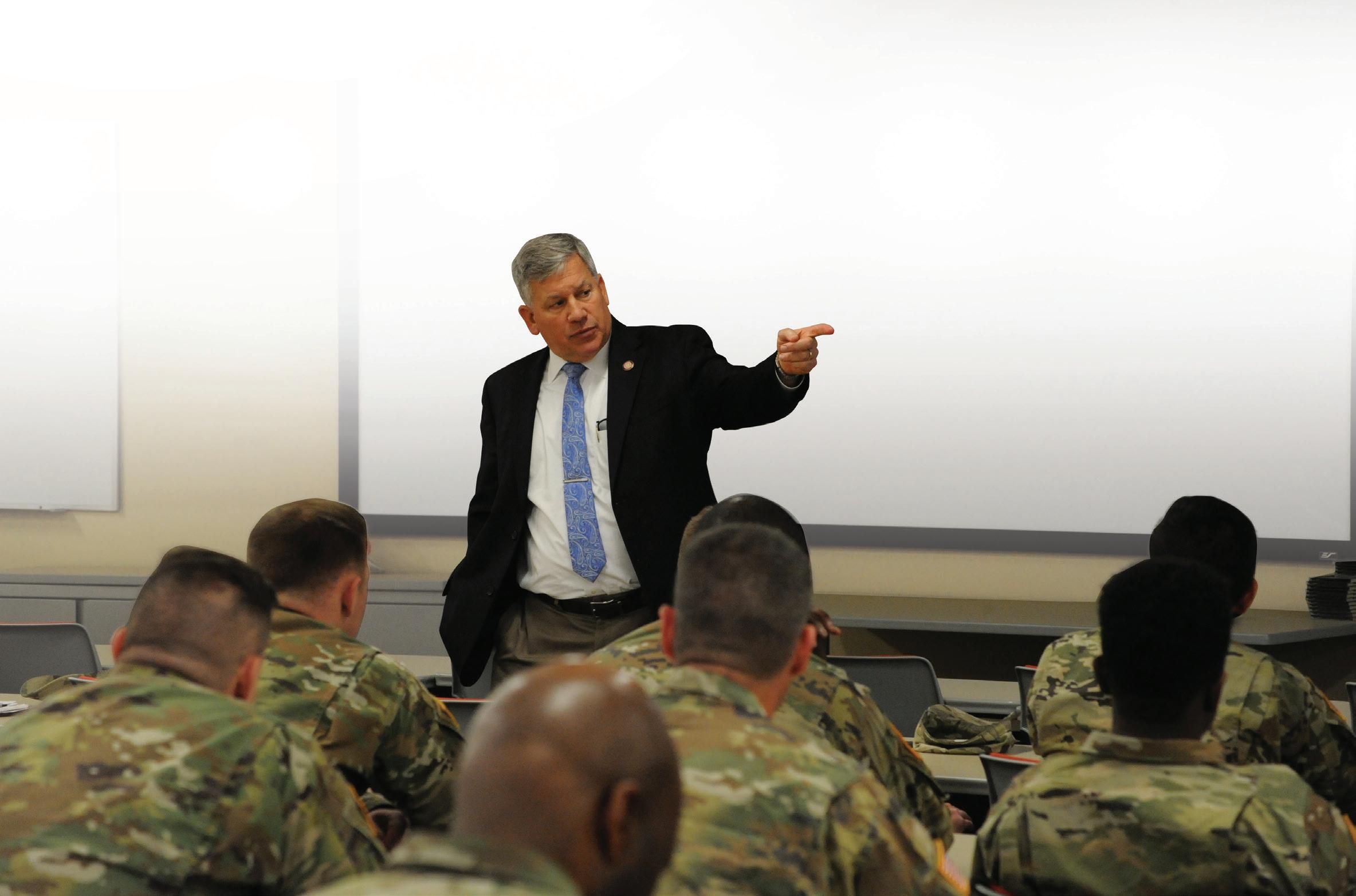 By Jessica Manfre
By Jessica Manfre
Army Emergency Relief revised eligibility requirements to extend financial assistance to non-Title 10 soldiers impacted by COVID-19.
Relief organizations typically require clients from the National Guard or reserves to be under Title 10 in order to qualify for assistance. AER recognizes the unique circumstances surrounding the COVID-19 pandemic — including the widespread financial impact on military families — leading to a waiver for certain requirements, on a case-by-case basis.
“When there are disasters that occur, we frequently put exceptions in place. If they are in that (bad financial) situation, we are going to help them,” retired Lt. Gen. Raymond Mason, director of AER, said.
Mason went on to explain the member must go through the normal process and take their request through their chain of command. This is something that can be difficult for some military members, as pride or fear of reprimand can get in the way of asking for help. Sgt. Maj. of the Army Michael A. Grinston has a message for them.
“AER is about soldiers helping soldiers in their time of need, and this is no different. COVID-19 may present some challenges for our Regular Army, National Guard and
reserve component soldiers and their families — they need to know that it’s OK to reach out and ask for help when they need it. That’s one of the best parts of being in our Army, you should always be able to count on the people to your left and right to be there for you,” Grinston said.
It’s critical that leaders are aware of the possible needs of soldiers and their families during this time. The goal is to build awareness of this assistance before financial crisis occurs, since the effects of coronavirus pandemic could span not just weeks — but months.
“If you know your squad really well and truly care about them, then you know when something’s off. NCOs at the SGT, SSG and SFC levels are the connection between our soldiers and the rest of the Army. They work with soldiers every day. Good NCOs and good
leaders in general know when it’s time to sit down and talk with their soldiers,” Grinston said.
AER and other branch aid societies exist to support the military and their families yearround. This pandemic is another example of how organizations intend to be there to support those in need. On average, AER distributes roughly $70 million dollars annually to 40,000 soldiers and families. There are over 30 different categories of financial assistance. Once approved for assistance, the money is electronically transferred immediately.
Although the relief organization is focused on supporting the Army, any military member can call or walk into their offices for support. AER, in turn, may contact the service member’s respective branch-specific relief organization and follow their guidelines. Mason shared that all relief agencies work closely together with the common goal of being there for those in need.
There is also no minimum or maximum dollar amount for assistance for soldiers, their families, and surviving spouses who have not remarried. Each application is evaluated based on demonstrated need.

According to the AER website, for nonTitle 10 Army National Guard and Army Reserve soldiers experiencing hardship from COVID-19, such as unusual financial hardship due to a canceled deployment or the current DOD travel ban, notify your field grade officer or command sergeant major in the chain of command of your intent to submit an assistance application and request a DOD SAFE secure document upload link.
Visit https://www.armyemergencyrelief. org/covid19/nontitle10reserve/ for additional steps in the application process
“To the soldiers and families who are feeling the financial impact of this virus — your chain of command, the Army and AER are here to help. Don’t be afraid to step up and talk about it. We’ve got your back. I’ve got your back,” Grinston added.
Visit https://www.armyemergencyrelief. org for more information on AER programs and services.
Sgt. Maj. of the Army Michael Grinston.The National Guard is expanding suicide prevention efforts to help units identify risk factors and implement intervention techniques.
According to the latest “Department of Defense Annual Suicide Report” released in September 2019, while suicides among the active component have been steadily on the rise over the five years between 2013 and 2018, suicide rates among members of reserve component have remained steady and on par with the general civilian population.
The same report revealed the National Guard had the highest suicide rate among all military components, at 30.6 per 100,000 Guard members. In order to combat its suicide rate, the Bureau has expanded its approach to suicide prevention, according to information provided by National Guard spokesman Maj. Robert Perino via e-mail.
“The Warrior Resilience and Fitness Division was established to synchronize Air and Army National Guard well-being, resilience, and suicide prevention efforts across the 54 states, territories and DC. The goals are to align, promote and
enhance wellness and prevention best practices and provide strategic oversight for outreach, innovation pilots and data analysis,” Perino said.
The information provided by Perino includes several National Guard key strategic initiatives:
• SPRING (Suicide Prevention and Readiness in the National Guard): Builds an evidencedbased, data-driven tool to help leaders make informed decisions about the health and well-being of National Guard members.
• Warrior Resilience and Fitness Innovation Incubator (WRFII): State-level pilot programs designed to enhance the readiness, wellness and resilience of geographically dispersed National Guard members. WRFII operated 11 pilot programs in Fiscal Year 2019.
• Vet Center Outreach Initiative: Formal partnership between the National Guard Bureau and the Department of Veterans Affairs to provide greater access to behavioral health services for National Guard members and
their families. 300 Vet Centers and 80 Mobile Vet Centers are augmenting existing services provided to National Guard through a Memorandum of Understanding signed in June 2019.
In the Army National Guard, initiatives include suicide prevention training and Master Resilience Training. Additionally, a National Guard brigade in South Carolina is participating in the Secretary of the Army’s Suicide Prevention Proof of Concept through fiscal year 2021.

“This proof of concept targets several new trainings to specific ranks and leadership levels, provides commanders with new risk assessment tools and embeds performance experts into each company that will operationalize resilience in their units,” Perino said.
The Army National Guard also provides direct assistance to commanders to evaluate unit risk including substance abuse, violence and suicide. This helps commanders implement mitigation strategies that are tailored to their units.
For the Air National Guard, initiatives include quarterly
leadership talking points that assist leadership in having conversations with their members using “safe messaging.”
“The intent of theses talking points and videos is to spend a few minutes during a regularly-scheduled meeting/ briefing to discuss suggested topics and engage with their members in a meaningful way, building connections, and strengthening relationships,” Perino said.
The Air National Guard also created a suicide analysis board in March 2019 that included an in-depth review of 12 Air National Guard suicide deaths from calendar year 2018. In response, the board developed 11 recommendations to prevent future suicide deaths.
According to Perino, the first step to noticing the warning signs of a potential suicide is noticing either changes in behavior or entirely new behaviors.
“Warning signs could include how a person is talking (examples: feeling hopeless, trapped, no reason or purpose to live, being in unbearable pain, being a burden to others, saying goodbye, etc.), their behavior (examples: changes in alcohol or drug use, searching for a way to end their life, withdrawing or feeling isolated, sleep changes, aggression, giving away personal items etc.) or their mood (examples: depression, anxiety, loss of interest, recklessness, sudden changes in mood-both positive or negative, relief or sudden improvement, etc.). You do not have to see every warning sign to act, but most people who take their lives exhibit one or more warning signs, either through what they say or what they do,” according to written materials provided by Perino.
Suicide prevention in the National Guard presents some unique challenges in comparison to the active component, Perino added. Geographic dispersion, time between drill activities, access to care and eligibility for healthcare are all potential factors in how difficult it may be to spot the warning signs of suicide.
“We continue to study how these factors impact the well-being of the NG. Findings from evidence and program assessments are used to inform WRF programs and initiatives, including the development of SPRINGboard, which is a tool for analyzing critical data on readiness and resilience in the NG,” Perino said.
There are numerous resources for National Guard members.
“Guard members can reach out to their leadership, their unit chaplains, the Director of Psychological Health and Family Assistance Centers in their state,” Perino said. “There are also national hotlines to provide support and coaching.”
Other resources Perino outlined include:
• Resources by state are included at https://www. nationalguard.mil/Resources/ State-Websites .
• A Director of Psychological Health exists in every state, territory, and Washington D.C., and provides assessments, support, and referrals to local resources.
• National Guard Family Assistance Centers provide a variety of referral-based
services to geographicallydispersed families and retirees from all military components. Services include, but are not limited to, crisis intervention and referral, community and legal information and referral, and emergency financial services. Find Family Assistance Centers at https://installations. militaryonesource.mil/ .
• Give an Hour is a network of Mental Health Professionals that offer National Guard, Active Duty, reserves, and veterans no cost mental health services to increase access to care. WRF partnered with Give an Hour on the Campaign to Change Direction. https://www. changedirection.org .
In an immediate crisis connect on the phone or via chat:
Veterans Crisis Line: Soldiers or airmen in suicidal crisis should call the Crisis Line at 1-800-273-TALK (8255) - press 1 for veterans.
Real Warriors Campaign: The campaign aims to reduce the stigma of psychological health concerns and encourage Service members, veterans, and their families to reach out for care. To confidentially speak with trained health resource consultants 24/7, contact the Psychological Health Resource Center at 866-966-1020 or use the Real Warriors Live Chat http://www.realwarriors.net/livechat.

The prospect of needing long term care may be far from your mind today, but circumstances can change. A long term care event can happen at any age, and the potential financial and emotional strain that comes with it can have an impact on you and your loved ones.
Did you know millions of Americans require long term care during their lifetime, which includes the need for either cognitive or physical assistance with simple tasks like bathing, eating, and dressing — trivial things most of us do every day without a second thought? Unfortunately, traditional health insurance plans — including TRICARE For Life — do not pay for the chronic, ongoing assistance with daily living that is most often associated with long term care.
In fact, the long-term care benefits offered through the Department of Veterans Affairs are tied to specific triggers, including service-connected disability, available funding, and even your ability to contribute to the cost of care. Long term care can be expensive, and service members often rely on the VA to cover the associated costs. Depending on your eligibility status in the VA program, the level of coverage available to you may not be enough. For this reason, you may want to research standalone long term care insurance like a plan offered through the Federal Long Term Care Insurance Program (FLTCIP).
Since its launch in 2002, the FLTCIP
has offered active and retired members of the uniformed services the opportunity to help take control of their future long term care needs. Designed to provide solutions for a range of financial situations, this employer-sponsored program offers comprehensive coverage for more than 270,000 enrollees.
Many members of the federal family are eligible to apply for coverage under the FLTCIP, including active and retired members of the uniformed services. Certain family members, or qualified relatives, are also eligible to apply even if you do not. Qualified relatives include your spouse, domestic partner, parents and parents-in-law, and adult children.
This article is a submission by LTC Partners. The FLTCIP is sponsored by the U.S. Office of Personnel Management, insured by John Hancock Life & Health Insurance Company, and administered by Long Term Care Partners, LLC.
WITH THE FEDERAL LONG TERM CARE INSURANCE PROGRAMThe FLTCIP is designed to reimburse for qualified long term care services and can lessen or eliminate an individual’s reliance on a loved one to provide hands-on care. As you assess the FLTCIP’s value, consider these important benefits:
• The FLTCIP offers coverage in a variety of settings — at home or in a facility, such as an assisted living facility, an adult daycare, or a nursing center — and your choice of caregiver.
• If home care is your preference, the stay-at-home benefit includes a range of services that support care in your home, helping you maintain your quality of life in familiar surroundings.
• Informal care provided by friends and family members, as long as they do not live in your home at the time you become eligible for benefits. (Note: Benefits for care provided by family members is limited to 500 days.)
• The program’s care coordination services offer enrollees and their qualified relatives’ information about long term care resources, such as local care providers and relevant community programs, as well as valuable support to your family and friends.
Talk candidly with your family members and tell them about the FLTCIP. Starting the conversation prior to needing care can help you prepare for the unexpected. Visit LTCFEDS.com/militaryfamily to learn more about the benefits of applying for the FLTCIP.
For personalized assistance, call 1-800-LTC-FEDS (1-800-582-3337) TTY 1-800-843-3557 to speak with
a program consultant. They are available to answer any questions you may have and can walk you step-by-step through the plan design and application process.
Note: Certain medical conditions, or combinations of conditions, will prevent some people from being approved for coverage. You need to apply to find out if you qualify for coverage under the FLTCIP.
Established by an act of Congress in 2000 and overseen by the U.S. Office of Personnel Management, the FLTCIP is designed to meet the specific needs of the federal family. The long term care insurance under the FLTCIP provides industryleading benefits and offers flexible options that allow enrollees to tailor coverage to meet their needs.
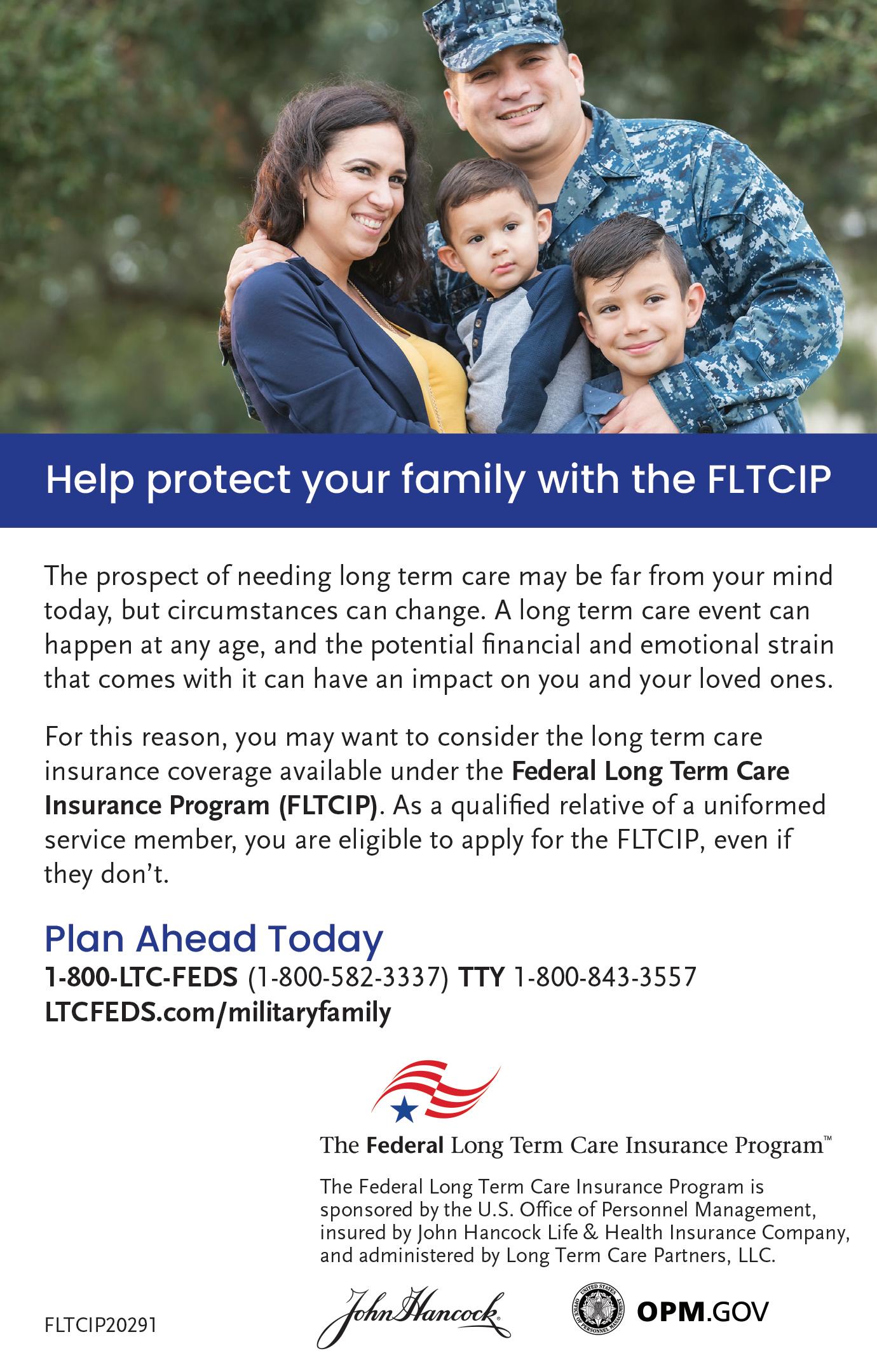
When the New York Army National Guard’s 42nd Infantry Division, nicknamed the Rainbow Division, deployed to the Middle East in support of Operation Spartan Shield in January, three members of the Valenza family, Maj. Julie Valenza, her husband, Sgt. 1st Class Will Valenza, and their youngest son, Sgt. Andrew Valenza, were among its ranks.
According to Maj. Jean Marie Kratzer, the public affairs officer for the 42nd Infantry Division’s Headquarters and Support Company, a family with these many immediate family members deploying together is rare.

“They are all super close,” Kratzer said, noting the family often has at least one meal daily together.
Julie, also known as mom, deployed with the National Guard in 2012 to Afghanistan and knows first-hand how hard it is to be away from home and family. She also knows how fortunate she is to deploy with her husband and son.
“Deploying together is actually looking to be a great experience,” Julie said. “Even though we won’t
be together every day, we will see each other more than other families who have someone deployed. We take whatever time together that we can get and know how fortunate we are to get it.”
Julie is a physician assistant in the division and works with the surgeon on clinical operations. Previously, she worked in a medical company providing care to soldiers during military exercises and deployments. In her civilian life, Julie has spent the majority of her career in a medical practice in Upstate New York.
“I joined the National Guard 10 years ago at age 45, one year after my husband reenlisted after a 16year break in service,” Julie said. “I joined because there was a need in the National Guard for medical providers, and I felt it was my time to serve.”
Julie’s husband, Will, is a civil affairs noncommissioned officer serving in the 42nd Infantry Division. He initiated the family’s commitment to serve when he joined the New York Army National Guard in 1986. After six years, he transitioned to a civilian career in law enforcement, eventually joining and retiring as chief of police in Glens Falls, New York. In 2009, Will reenlisted in the New York Army National Guard at the age of 43.
“When I told my wife, she said to go for it,” Will said. “It took a little work, but I was able to reenlist and went right into the recruiting command as an instructor.”
Julie and Will’s youngest son, Andrew, followed in the footsteps of his older siblings and enlisted on his 17th birthday in 2015. He now serves as a combat documentation and production specialist in the
42nd Infantry Division.
“My job is to tell the Army’s story through photography and video productions,” Andrew said.
Motivated to voluntarily deploy with the division, Andrew expedited his college studies.
“I completed my degree early because I wanted to be able to come on this deployment without anything weighing down my ability to focus on the Army mission,” he said.
For the Valenzas, serving is a family affair. Their oldest son, 1st Lt. Mitchell Valenza, joined the New York National Guard at the age of 17 and completed basic training before his senior year of high school. He graduated from West Point. A platoon leader with the 82nd Airborne, Mitchell will return from his tour in Afghanistan later this spring. Julie and Will’s daughter, Camille, followed suit and also enlisted on her 17th birthday. A recently-commissioned 2nd Lt. in the New York Army National Guard serving as a field artillery officer, Camille is remaining in Upstate
New York while her family deploys.
Julie and Will believe all of their children benefit from serving in the military.

“We hope they will continue to grow with a sense of selfless service and loyalty to their country and community,” Julie said of her children. “The Army has helped prepare them for life both morally and financially. We are proud that they understand that and appreciate it.”
As a medical provider, Julie will be deployed with the division for six months, while her husband and son will each deploy for an 11-month tour. She understands there is a strong possibility she will eventually separate from her family during this deployment because they are all charged with doing different jobs, which may scatter them to different locations. For now, she is relishing the time they do have together.
“Being in the military does provide a special bond for us,” Julie said. “We know how lucky we are to go through the experience of serving together as a family.”
For others in the process of refinancing their homes, fluctuating interest rates are a point of concern right now.

Caliber Home Loan’s Military Lending Senior Vice President Bryan Bergjans understands the fears of the unknown and feelings of being unsure of when to lock in a rate for refinance.
“Military families should take a sniper approach to refinancing their loans and basically hide in the bushes and watch their target,” he explained. Bergjans adds that watching the rates is the best tactic, especially with the current market being so erratic.
As the world continues to feel the devastating economic effects of COVID-19, military families are facing unprecedented circumstances. The pandemic has wreaked havoc on deployment orders, international and domestic travel, and drill weekends. For those Guardsmen or reservists in the process of selling their home, refinancing, or beginning a new home loan process, they are in limbo.
With states shutting down all non-essential businesses, the loss of income is being felt deeply throughout every community. Many military families may even find themselves unable to pay mortgages, especially if they are incurring multiple house payments because new orders are paused.
Although concerns regarding career impact when voicing financial issues is a long-standing barrier for seeking help, this is not the time to allow that fear to take hold. The world is suffering from financial loss and it is prudent that military families utilize the resources available to them to prevent long-lasting financial impacts from taking root. Proactive
planning now can prevent reactive steps in the future.
Contact your loan servicer immediately if you anticipate being unable to pay your mortgage. Most, if not all, lenders are ready and prepared to set up forbearance plans, which can provide relief of 90 days or more of schedule mortgage payments. You will eventually need to make those payments, but the forbearance allows a much-needed cushion for those impacted by COVID -19.
Barry Habib, a known mortgage expert and frequent commentator on Fox Business Network, weighed in on the impacts of COVID-19.
“The mortgage market is changing rapidly due to the effects of COVID-19 on the job market and overall economy. The availability of mortgage products and interest rates are very volatile during this time. It is crucial for military and veterans to consult with a well-informed mortgage advisor in regards to their financing needs during this rapidly changing environment,” he said.
He also shared that patience will be required during this time because lenders are becoming increasingly overwhelmed with fulfilling borrower’s needs. And that level of understanding should extend to the home buying process as well, since appraisals and closings are severely impacted by the social distancing requirements. For those navigating the VA home loans process, know that industry professionals are working diligently to make the process smooth, although there will be delays. Again, patience will be key.
Although this is a challenging time for all families, those in the military community can weather this and more. There is ample support readily available and many resources to assist military families through financial concerns caused by the COVID-19 pandemic.
Visit Caliber Home Loans to learn more about how its team of military and veteran lending professionals can assist your family with the home buying process. Caliber remains committed to serve those who serve and will continue to do so even in the midst of a pandemic.


Hundreds of service members are finding off-duty refuge in esports.

The area around Joint Base Lewis McChord, Washington, is known for its lush evergreens and pristine mountains. Mount Rainier is a fixture on the eastern horizon. Puget Sound is to the west. Closer to home American Lake offers easy access to fishing and boating opportunities. Every year thousands of in-processing service members are told what a wonderful place JBLM is for those who enjoy hunting,
fishing and camping. That’s why it may surprise some to see that some of the base’s most unique recreational opportunities take place indoors amongst the flickering lights and big-screen televisions of a state-of-the-art video gaming facility. The base has embraced esports in a big way, according to Josh Soldan, Directorate of Family Morale Welfare and Recreation Community Recreation Officer.
At the center of JBLM’s esports operation is The Warrior Zone, a high-tech recreational facility
featuring 16 gaming stations for X-Box One and PlayStation 4, each with 55-inch monitors, 32 gaming computers and six Nintendo Switches.
The Warrior Zone is a popular destination among JBLM service members, with between 450-500 visitors daily. Monthly tournaments ranging from lighter games like “Mario Kart” and “Smash Bros” to more serious games like “Call of Duty” draw as many as 100 participants per event. Intense players can get in on the occasional
“Fortnite” tournament, while the more whimsical can dress as their favorite superhero during an “Injustice 2” tournament.
Other military installations offer esports opportunities, but not to the extent that JBLM does, according to Soldan.
But it’s not the high-end equipment and free Wi-Fi that truly drive the monthly gaming tournaments, Twitch streams and SHOUTcasting. The driving force behind JBLM’s gaming empire is Recreation Program Manager Bill Strock.
“We offer the most opportunities,” Soldan said, “and the coolest opportunities.”
At 65 years old, Strock doesn’t look like the face of cutting-edge entertainment opportunities, but he’s been creating opportunities for service members to play video games competitively since 1993.
“What I bring to the table is the ability to listen to what soldiers want,” Strock said. “The military breeds a lot of the things you need to be a great gamer, like reaction time and focus.”
Strock said esports offer a valuable outlet to service members and contribute to resiliency by giving gamers, who might otherwise spend a lot of their free time alone in their rooms, a place to be social and meet with those who have similar interests.
“It helps prevent depression and things that happen when you’re alone in your room,” Strock said. He added there’s benefits to MWR as well. Online gaming has a relatively low cost and low logistical demands compared to other types of recreation.

“It’s not just good for soldiers but good for our pocketbook,” Strock said. “We can easily play a guy from Fort Lewis against a guy from Fort Campbell while a guy at Fort Eustis SHOUTcasts.”
Strock said his forays into esports began when he learned soldiers were having LAN parties in the nearby town of Dupont where they played games like “Counterstrike” and “Diablo”. This led to Strock hosting his own LAN parties at JBLM’s Nelson Recreation Center. Those initial parties led to interservice tournaments and eventually large events with big prizes and corporate sponsorships.
Last year USAA donated $88,000 to MWR’s esports efforts. In the near future, Strock said, JBLM MWR has plans to develop a relationship with the professional gaming organization “Evil Geniuses.” MWR personnel from other military
installations have also expressed interest in learning how JBLM conducts esports events.
Strock said at least four JBLM service members have gone on to join Army esports teams, including two “Call of Duty” players and two “Street Fighter 5” players.
And he didn’t stop at organizing game tournaments. Strock’s hired professional streamers to coach service members in Twitch streaming and “SHOUTcasting.” He said video game commentating is a viable career path for young people leaving the military and wants to enable them to pursue their passions.
“It’s a very viable world for a young guy to get in to,” Strock said.
To view the Warrior Zone’s Twitch channel visit https://www.twitch. tv/jblmwarriorzone/videos.
 By Sarah Streyder, Secure Families Initiative
By Sarah Streyder, Secure Families Initiative
we do not necessarily have plans to get married right now. How might us not being married affect our experience in the reserves?
P: If you are dating and happy, you will continue to be both these things. Oftentimes, people feel compelled to make different decisions because they are facing a change in circumstance, and divorces in the military are quite high because of these rushed decisions.
As an unmarried partner, you will usually be welcome with open arms to any spouse activities anyway. However, you won’t get all the official benefits of a spouse, like an identification card to access military installations, medical care, etc., but that’s no reason to rush such an important decision.
K: What are the chances my partner will be deployed overseas as a reservist? Is there a difference in being deployed as a reservist versus active duty?
Joining the reserves is a big transition for the whole family.
My friend Kristina recently shared with me her mixed emotions of pride and anxiety toward her partner joining the reserves soon. So, I introduced her to Patricia Johnson, a military brat, former Army Reservist spouse, and lifelong promoter of military families. Below are the pieces of advice that she offered Kristina:
K: I’m proud of my partner for choosing to join the reserves, but at the same time I’m worried. I feel a bit guilty for that second feeling. Is this something partners normally feel? How do you manage those feelings while remaining supportive?
P: A call to service is something that not everyone understands as deeply as the person who feels called. When someone decides to join our military, they feel as if they know the risks and are prepared to face them. But as a partner who doesn’t feel the same calling, how can we not worry?
Worrying is normal. And sometimes loved ones even feel resentful that their partner is going to spend time away to pursue this calling. Express your feelings and be transparent. But ultimately, extend trust to your loved one — trust that their decision was made with care and thoughtfulness.
K: My partner and I have been together for over two years, and while we’ve discussed marriage,
P: The chances of being deployed as a reservist in today’s world are quite high. If your spouse/partner deploys, remember they will be forever grateful to have had this opportunity because their loved one supported their decision.
Active duty and reservists were, at one time, at odds. But nowadays, reservists have earned a lot of respect, and their active buddies are glad to have them at their side.
Active-duty spouses/partners are much more comfortable in their role because it is familiar, and their peers are almost always other military folks. Reserve spouses/partners can feel lost in the complexities of a world they normally do not occupy.
That is why it is good to meet with other partners in person when you get the chance. They will have a lot of empathy for what you are going through and strategies on how to handle some of the stresses that are likely to occur.

K: In what ways might my career choices or political opinions affect my partner’s military career and experience?
P: Although the military is considered an apolitical institution, members of the military may not share your opinion on a number of issues because their background and experiences have been different from yours. You may get “teased” about your opinion or your job.
But your career choice and political opinions are your own. The more people get to know you, the more they will be comfortable with your
differences. Who knows? Maybe they will even change their minds.
Stay true to yourself. The military respects strength and resilience.
K: As someone who is now personally affected by foreign policy decisions that impact military families, how can I make my voice heard on those issues?
P: Always, always vote. Run for office. Volunteer on a campaign. Also, there are many advocacy organizations you can join. The Secure Families Initiative is one great example! It provides training for military partners who want to become advocates, and opportunities to take direct action.
Being a part of one of the largest, strongest, oldest organizations in America should fill you with resolve to engage in your own battles,
march for issues you care about, and fight for what you believe is right and just.
K: Any additional advice for me?
P: Due to the nature of the military, spouses/partners don’t always have a voice in matters that affect the lives of their loved ones in uniform. We have come a long way from the days of the joke: “If a soldier needs a spouse, we will issue him one.” But we only got this far because we spoke out.
Earn trust and respect from the people you meet in your spouse’s unit by always being truthful, transparent, and willing to accept that others may feel wildly different from you. You will meet a very diverse group of people. It may be frustrating at first, but you will eventually learn the best way to have the most impact.
